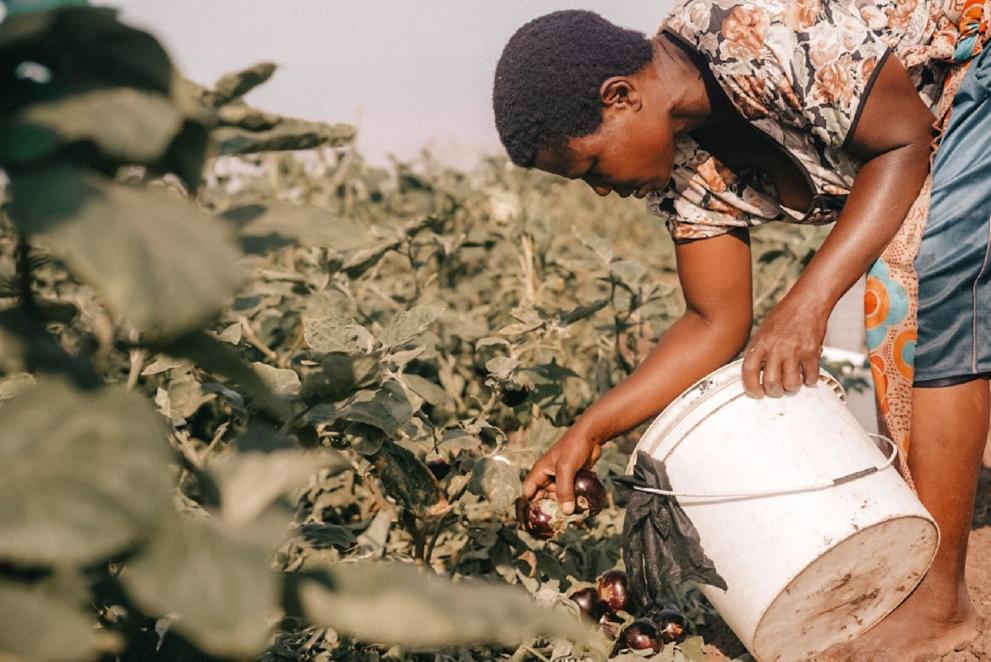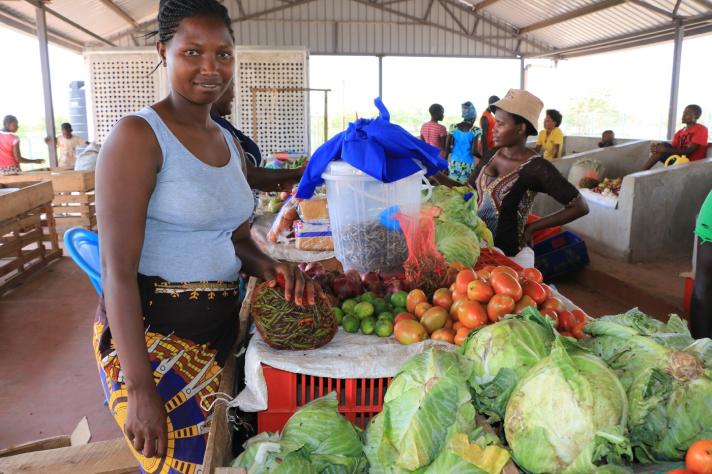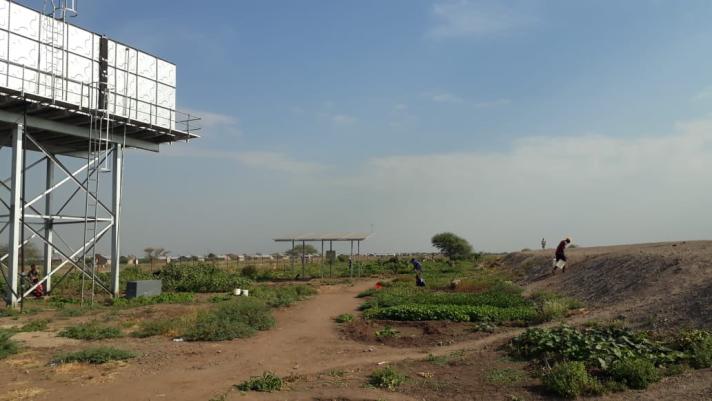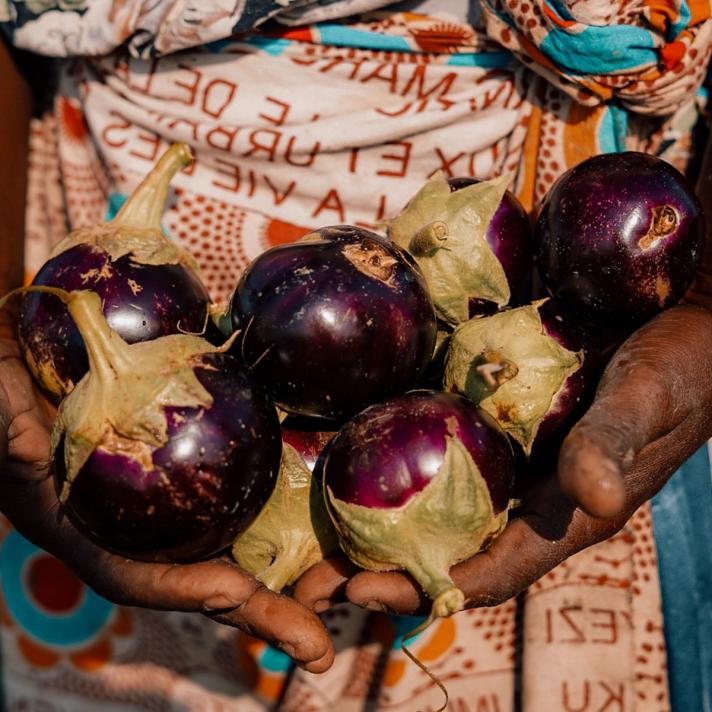
The World Food Programme (WFP) programme, financed by the Emergency Trust Fund for Africa (EUTF), has provided long-term support to farming amongst local and refugee families in Kenya. It also proved to be a lifeline during the pandemic.
Story by Martin Karimi
Do you fancy some mukeke — smoked fish — from Lake Tanganyika, or locally grown leafy vegetables whose roots you can trace to the lowlands of South Sudan? Or are you hosting festivities that require a plentiful supply of fresh camel cuts?
Chances are, the Kalobeyei fresh food markets will meet all the desires of your palate. And even throw in some extra fresh spices!
Kalobeyei is about 20-minutes from the Kakuma refugee camps in the arid Turkana county, northwestern Kenya. Unlike the camps, it was established with local authorities as an integrated settlement where the local people and refugees live side by side.
The food markets here are a melting pot of ingredients, much like the diverse nationalities living in the settlement. The markets cater to distinct tastes and cultures, stretching from the meat-loving Somali in the Horn to tuber-growing generations from the Great Lakes.
Relying on locally grown produce more than ever
Most fresh food vendors in Kalobeyei and Kakuma markets are women, and the majority are refugees.
Traditionally, they sold cabbage and tomatoes sourced from as far as Kitale market, 400 km away; and red onions from across the border in Uganda’s Moroto, a town about 260 km away.
However, with movement restrictions imposed as a result of the global COVID-19 pandemic, the supply channels from Kitale and Uganda have been disrupted. The dusk to dawn curfew means that trucks are taking longer to reach Kakuma, the produce costs more and it is often no longer fresh by the time it arrives at the stall.
But on the bright side, this has led to an increase in demand for vegetables grown locally such as a variety of leafy vegetables, eggplant, and okra freshly plucked from gardens dotted around the settlement.
Transformed by water
Apolina Mohoza is one of the traders farming along the banks of the Kalobeyei water pan, once a dry bare plain, now dotted with green plots of leafy vegetables. Apolina’s gardens are a 15-minute walk from a newly-built modern markets christened Natukobenyo.
“I have about 10 plots growing different types of vegetables at the [Kalobeyei] water pan,” says Apolina. “I’m assured of harvesting from each plot at least once a month.”
When Apolina can’t harvest enough from her plots, she buys from other farmers and aggregates for the market.“One bundle is ten shillings,” she tells a prospective buyer who is holding up a bunch of murere, a traditional favorite for South Sudanese families. Each contains about 10 stems tied together with a string. When the woman hesitates, she throws in a discount.
“You can take the three bunches for twenty shillings.” That catches the attention of the woman. Money changes hands. It is a good deal for both women. That bunch is from yesterday’s stock and Apolina has just brought in a fresh supply from the farm.
Apolina normally sells matembele (sweet potato leaves), murere, cassava leaves, amaranth, pumpkin leaves, and cowpea leaves — all grown in Kalobeyei. With less and less produce arriving from outside, the demand is growing and so are the prices.
Better hygiene, health and nutrition
When Kalobeyei settlement opened in 2016, there was little infrastructure and the arid landscape did not show much promise for farming. However, with support from the European Union, specifically the EUTF, the WFP built water harvesting structures, gardens, shops, and modern markets.The transformation has meant that refugees and the host population can now irrigate small plots growing vegetables for consumption and sale, operate businesses and run grocery stalls in the local markets.
Before WFP built the new markets, grocers, commonly known as mama mboga (female vegetable vendors), used to shelter from the harsh sun under canopies of multi-coloured umbrellas or makeshift sheds made of sticks and tarp.These markets would thrive only in the evenings because of the blistering daytime heat. And even then, to keep the produce looking fresh and attractive, the women would constantly sprinkle it with precious water or wipe dust off using moist pieces of cloth.Things are different now. It is just after midday and the sun is high up in the sky and the market is vibrant. Men and women are buying ingredients for the day’s meals.
Francine Uwimanimpaye is selling cabbage, tomatoes, onions and chilies all laid out on a raised platform in the Natukobenyo market.“This market is way better than the roadside sheds or the bare ground where we used to sell groceries,” she explains. “We used to lay vegetables and fruits on mats along foot paths. The groceries would gather dust and wither quickly due to the heat form the floor. We don’t have that problem here.”Tereza Mutenga is another vendor who has recently occupied a stall at the new and modern market structure.“I find this market good for my business,” says Tereza. “I used to sell vegetables from my house or sometimes hawk mandazi (buns) in the town centre to earn some cash. Here, there are many people walking through, so I make more sales and therefore more profit.”Tereza, just like Francine and Apolina, is diversifying her family’s diet with sales from her stall.
“I use the profit I make from the market to buy food, on top of the Bamba Chakula cash [WFP’s cash transfers supported through the EUTF],” she says. “For instance, if my children don’t want to eat omena [small dried fish], I go to a butchery and buy some meat.”Engineering works fit for the harsh climateWith the support of the European Union, WFP has built three modern markets — two in Kalobeyei settlement and one in Kakuma town.
The open-air market structures are covered with a high roof protecting traders against the harsh sun or rain while allowing ample air circulation and currently host 122 traders; most of them drawn from the refugee community.With each stall comes a lockable storage space. The stalls and the floor are cemented and easy to clean. In the fenced-off compound, WFP has installed a water tank to harvest rainwater for general hygiene and has also provided sanitation facilities.
Each market is also fitted with a low-cost cold storage room that uses charcoal and water to keep produce fresh for longer. This is a game-changer in these markets where temperatures constantly flirt with the 40-degree Celsius mark.But that is not all. The new markets also give space to non-vegetarians. Each of the three markets hosts ten meat shops.Food safety all aroundJoseph Manirakiza is one of the butchers who now owns a new shop in the Tumaini market in Kalobeyei village 3. Prior to moving up to Kalobeyei, Joseph owned a not-so-modern meat shop in the Kakuma camps. Chopping meat is a trade that he had learnt back at home in Burundi.
“My old butchery was not built to these standards,” he says. “This is spacious, secure and easy to clean — and we have water right here.”Joseph is now among the 100 meat traders who have also been gifted specially fabricated boxes to safely transport meat from the slaughter house to their various butcher shops in Kakuma town, the camps and Kalobeyei settlement.
Before WFP gave out the safe metallic meat boxes, traders ferried meat in sacks or normal storage boxes which are neither hygienic nor fit-for-purpose for this delicate food chain.“I used to struggle a lot before I got this meat box,” says Joseph. “I would buy meat at the slaughterhouse but by the time it gets to the shop, it is either contaminated with dust or mud during the rainy seasons.”
“This meat box has eliminated a huge headache for me,” he explains. “Transporting meat from the slaughterhouse to my stall [about 15 kilometres away] is now easy. “Thanks to the EUTF, WFP has fabricated 100 boxes and distributed them in and around Kakuma and Kalobeyei.
Low-cost investments, far-reaching results
These programmes implemented by WFP in Kakuma and Kalobeyei, which are financed by the European Union, are proving extremely vital at a time when Covid-19 is reshaping the way assistance is delivered. Even with supply chains affected by movement restrictions, families can still access diverse diets and better nutrition — because they can grow their own.
WFP’s actions are contributing not just to the availability of fresh foods in one of the driest parts of Kenya, but also to better quality and food safety across different value chains.As the local Public Health Officer Mr Peter Miitunda, attests, “The boxes from WFP have improved the way we handle meat. In turn, the quality and safety of the meat being consumed in our markets is better.”
“I can say that without any hesitation; all vendors used to come here with recycled gunny bags or storage boxes to collect meat,” he adds.For these refugee families living thousands of kilometres from home — uprooted by conflict or hunger — a taste of a favourite dish must be comforting — even better when they know that it is fresh and safe from contamination.
Details
- Publication date
- 12 June 2020
- Region and Country
- Kenya
- Thematic
- Strengthening resilience of communities
- Partner
- World Food Programme



